What Are the Characteristics of Classical Art Ancient Greece
Classic art styles from the ancient Greco-Roman periods take influenced the works of artists for centuries. What is information technology near the art from these periods that continues to inspire artists from Leonardo da Vinci to Banksy? Classical notions of proportion, balance, harmony, and elegance subtly permeate the sculptures, compages, and paintings of many mod art movements. In this commodity, we are going to take a deep swoop into the fundamentals of Classical art and explore its continued influence.
Table of Contents
- i A Wide Overview of the Classical Artful
- two Central Stylistic Contributions From Aboriginal Greece
- 2.ane 1600-1100 BCE: Early Mycenaean Influences
- ii.ii 776-480 BCE: Greek Archaic Period
- 2.3 480-323 BCE: Classical Greece
- two.4 323-31 BCE: The Age of Hellenistic Greece
- 3 Key Stylistic Contributions From the Roman Empire
- iii.i 509 BCE-26 CE: The Roman Democracy
- 3.two 27BCE-393 CE: The Imperial Roman Empire
- 4 Long Alive Classicism
- four.1 The Italian Renaissance: Classicism Fine art Revival
- 4.ii Neoclassicism: Reinventing Classical Ideas
A Broad Overview of the Classical Artful
The Classicism definition of art and compages from the Greco-Roman eras emphasizes the qualities of remainder, harmony, idealization, and sense of proportion. The human course was a common bailiwick of Classical art and was always presented as a generalized and idealistic figure with no emotionality. The composition and line in Classical styles are far more of import than the use of color.
Classical architecture is underlain past Classical concepts of mathematically precise proportions that create balance and symmetry. The eras of Greek and Roman Classicism saw a monumental level of architectural innovation, from the invention of cement to the employ of the dome. Elements of Classical architecture continue to permeate Western theories and practices today.
Before nosotros can investigate the influence of Classicism artists throughout the ages, information technology is essential to understand how the elements of the Classicism definition developed. The fashion spans centuries, cultures, and continents. We brainstorm with the primeval utterances of the Classical style in Mycenaean Greece and finish in the Majestic Roman Empire.
Primal Stylistic Contributions From Aboriginal Greece
Ancient Hellenic republic is the starting bespeak in our journey through Classicism. We can see the spark of Classicism in the vase paintings of the early Mycenaeans and the evolution of the gilded ratio. First, we await at the historical evolution of Ancient Greek civilisation, and then we volition look closer at some of the about important contributions to Classicism.
1600-1100 BCE: Early on Mycenaean Influences
The Mycenaean civilization is considered the first Greeks, and their style of art, sculpture, and architecture were primal edifice blocks for later Greek Classicism. Geographically, this elite warrior civilization spanned the coastal areas of mod-mean solar day Italy, Turkey, Syria, and Southern Greece.
Mycenaean society was governed by palace states and tin be separated into three classes: slaves, common people, and attendants of the male monarch. The king of each palace land wielded religious, political, and military authority. Heroic warriors and gods were worshiped by the Mycenaean people and early on Mycenaean art often pay homage to these figures. The tales of these gods and warriors lived on in afterwards Greek literature, like the Odyssey by Homer.
The drivers of Mycenaean geographical and political expansion were trade and agronomics. The Mycenaean engineering genius enhanced both of these drivers with drainage systems, dams, harbors, bridges, aqueducts, and a road network only rivaled by the Romans. Cyclopean masonry created enormous fortifications from large boulders held together with mortar.
These innovative architects created the relieving triangle, a mutual do today whereby a triangular space is left higher up the lintel to continue rock archways from collapsing.
Mycenaean societies were the beginning to create the acropolis hill-peak fortress that came to characterize subsequently Greek towns. The middle of the king's palace was a circular throne room often decorated with vibrant frescos. These frescos depicted goddesses and gods, battle scenes, the body of water, hunting parties, and symbolic processions. Following the Mycenaean era of prosperity, the Greek Nighttime Ages saw the Geometric way of vase painting.
Vase Painting
Although vase painting connected throughout the following periods of Aboriginal Greek history, it has its roots in the Mycenaean era. The vase painting of Classicism artists exemplifies the Ancient Greek focus on portraying the human form in an increasingly realistic manner.
Geometric patterns adorn the earliest vase paintings, but the focus quickly shifted to the human effigy. Following this, vase painting became more oriental, depicting Eastern motifs. The black-figure manner followed, using black to present more than authentic and detailed human figures.
Some other style of vase painting arose during the Classical Greek era using crimson rather than blackness figures. Vase painters in this style crafted man figures with strong outlines on black backgrounds. This technique allowed artists to paint the fine details rather than incising them into the clay. The resulting color and line variations are more rounded than the patterns from the Geometric era.
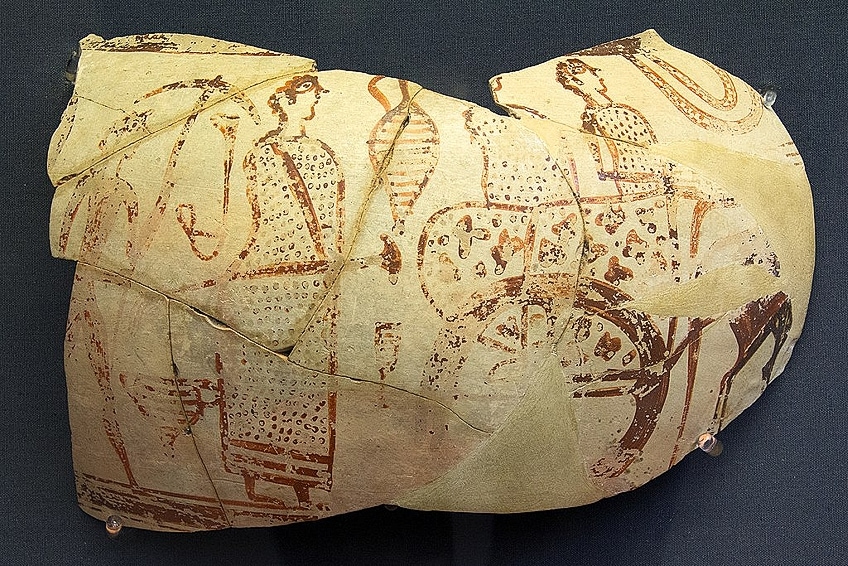 Mycenaean pottery fragment of a krater showing a chariot with charioteer and rider and two figures walking behind, 1400-1350 BC. Establish in Tobm 67, Enkomi, Cyprus; Zde, CC BY-SA 4.0, via Wikimedia Eatables
Mycenaean pottery fragment of a krater showing a chariot with charioteer and rider and two figures walking behind, 1400-1350 BC. Establish in Tobm 67, Enkomi, Cyprus; Zde, CC BY-SA 4.0, via Wikimedia Eatables
776-480 BCE: Greek Archaic Flow
The establishment of the offset Olympic Games marked the beginning of the Greek Archaic period. For this Greek culture, man achievement every bit personified past the able-bodied games fix them apart from "barbarian" people not of Greek descent. The Mycenaean era was valorized by the Archaic Greeks, leading to the idealization of the male person class.
For the Greeks of this menstruation, the nude male effigy represented the paradigm of bodily dazzler and character nobility. It stands to reason that the male class featured heavily in the Classical art of this Greek flow.
The Greek Primitive period also saw significant shifts in social and political life. The political and social system of the Archaic Greeks was based on the city-country. Sparta was a urban center with immense war machine ability, while Athens became the center of western fine art, philosophy, science, and culture. Effectually 594 BCE, a philosopher rex, Solon, created a political body that could claiming the rex and fundamentally shift the political mural of the day.
People were no longer placed into slavery for debt, and the ruling class was established based on wealth, not descent. Extensive bounding main-based trade collection the Greek economy, and many city-states began establishing settlements beyond the Mediterranean. As a issue, Greek cultural, creative, and political ideals spread to other European cultures similar the southern Italian Etruscans.
The most significant artistic innovation of this period in Greek history was figurative sculpture. These idealized yet realistic sculptures took influence from Egyptian sculpture and the idealization of the nude male form. The Cyclades islands were the birthplace of the get-go life-sized sculptures of immature women (kore) and men (kouros). Towards the end of the Archaic era, sculptors similar Nesiotes, Kritios, and Antenor rose to fame.
In 510 BCE, Antenor created the bronze Tyrannicides in celebration of Aristogeion and Harmonides, the ii assassins of Hipparchos. These 2 men symbolized the transition towards republic. The significance of this sculpture lies in the fact that it was the first recorded piece of publically funded art. The sculptor, Kritos, recreated the sculpture in the Early on Classical style with individual label and realistic movement, following its disappearance when the Persians invaded.
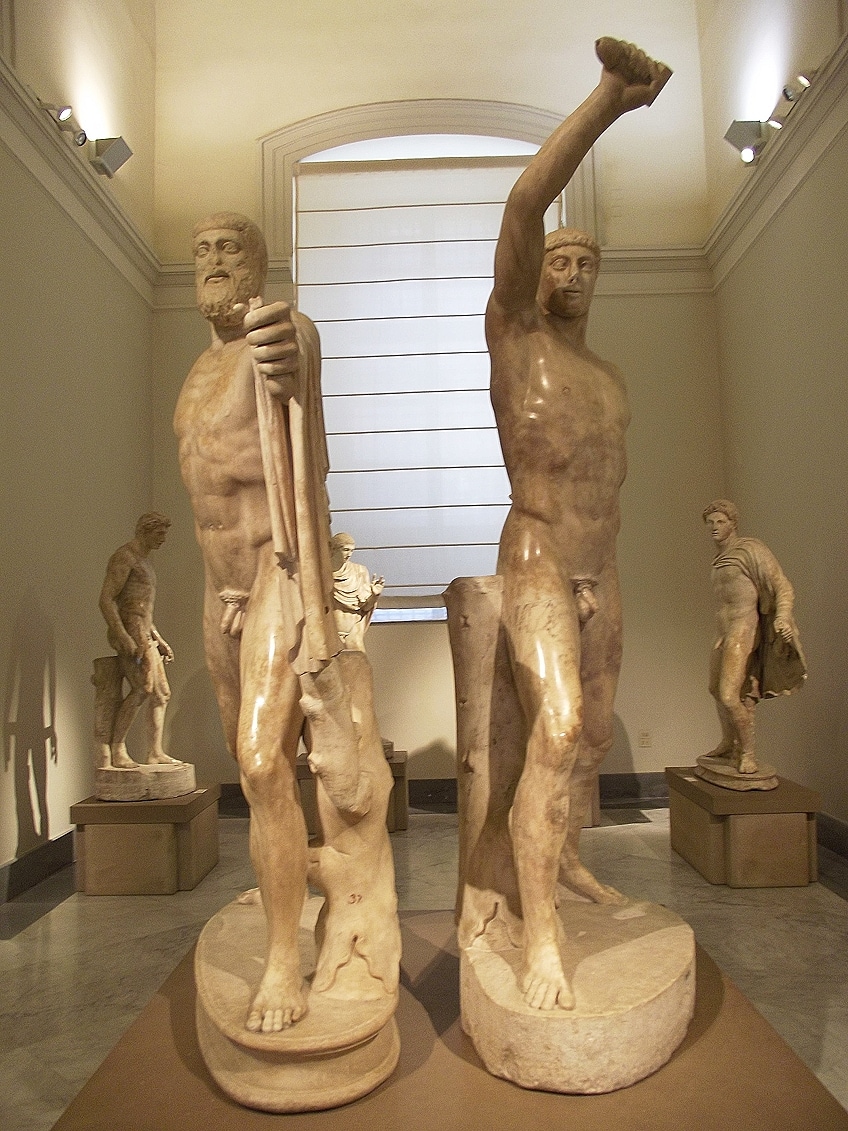 Tyrannicides(510 BCE) by Antenor; Elliott Brown, CC By two.0, via Wikimedia Eatables
Tyrannicides(510 BCE) by Antenor; Elliott Brown, CC By two.0, via Wikimedia Eatables
Greek Classicism Sculpture: Molding the Classical Fashion of Sculpture
Ancient Egyptian sculpture was very influential to Greek sculptors from the Primitive flow. Greek sculptors created life-sized sculptures of kouroi. There are iii singled-out types of kouroi: the standing and dressed young woman, the nude young man, and the seated woman.
Funerary monuments, votive statues, and public memorials featured the characteristic "Primitive grin". The sculpted representations of the human effigy were more idealistic than realistic and were rarely of individuals. Primitive Greek sculpture captures homo motility through realistic anatomy.
The late Archaic era saw the celebrity of sculptors similar Kritios, Phidias, Myron, Lysippus, and Scopus, to name a few. Discobolus, a sculpture by Myron, became famed for being the showtime sculpture to capture the remainder and harmony of homo movement in a moment. Classic Greek sculpture, as with painting and architecture, became increasingly focused on mathematically precise beauty. Polycleitus's systems of mathematical proportions focus on creating rhythm and balance through symmetry.
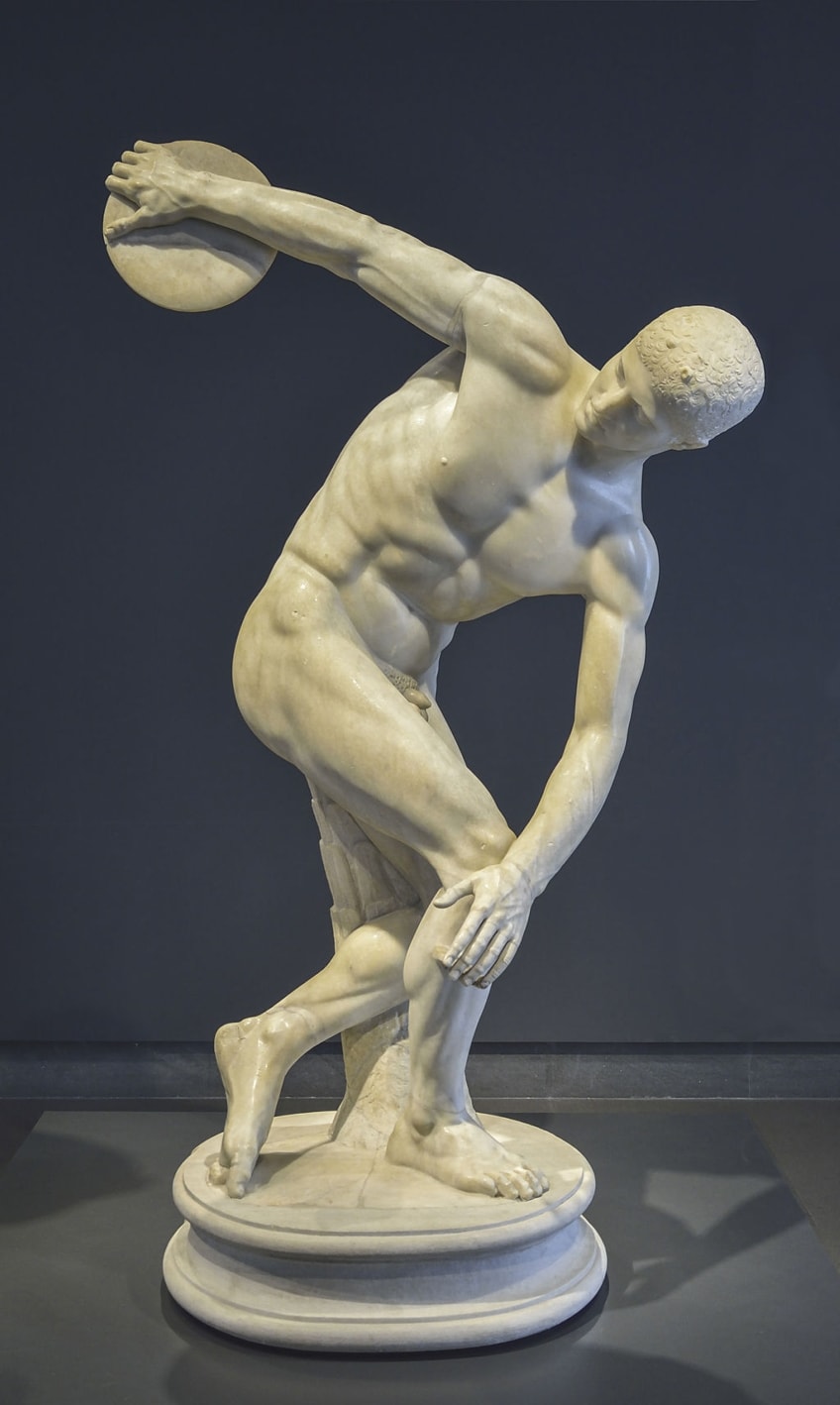 Discobolus (c. 140 AD) in National Roman Museum Palazzo Massimo alle Terme; After Myron, CC BY-SA iv.0, via Wikimedia Commons
Discobolus (c. 140 AD) in National Roman Museum Palazzo Massimo alle Terme; After Myron, CC BY-SA iv.0, via Wikimedia Commons
Early Greek bronze sculptures were created using hammered sheets held together with rivets. Techniques became more advanced past the end of the Archaic menses. Greek sculptors started to use the lost wax method of bronze sculpture. Large-scale sculptures were created past casting the bronze in several pieces. These pieces would and so exist welded together, and the teeth, eyes, fingernails, lips, and nipples were formed from copper inlays.
Unfortunately, a large number of the original Greek bronze statues do not exist today. The early on Christian era melted down several statues believed to represent pagan idols. Of those that remain, the Raice bronzes, the Charioteer of Delphi, and the Artemision Bronze are notable examples.
Likewise equally three-dimensional sculptures, Greek sculptors decorated temple entablatures with relief sculptures depicting mythological scenes and legendary battles. The Parthenon Marbles, created by Phidias, are possibly the about famous examples of this mode of Classical Greek sculpture. These relief sculptures are known for their dynamic movement and realism and decorated the temple chamber'due south interior walls. This sculpture, and other reliefs of this fourth dimension, have influenced later artists like Auguste Rodin.
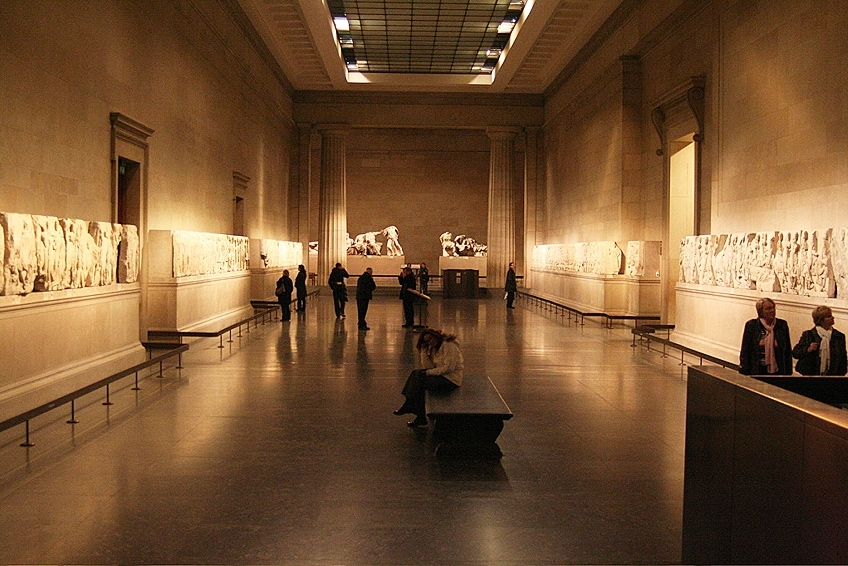 Parthenon marbles in the British Museum; Discobolus in National Roman Museum Palazzo Massimo alle Terme Nic McPhee from Morris, Minnesota, United states of america, CC Past-SA 2.0, via Wikimedia Eatables
Parthenon marbles in the British Museum; Discobolus in National Roman Museum Palazzo Massimo alle Terme Nic McPhee from Morris, Minnesota, United states of america, CC Past-SA 2.0, via Wikimedia Eatables
Chryselephantine statues in gold and ivory were a popular form of Classicism sculpture during the early Primitive menstruation. Phidias worked in these mediums, creating the 43-human foot-tall Statue of Zeus at Olympia (435 BCE) and the almost 40-pes-tall Athena Parthenos (447 BCE). A wooden structure is a footing for both of these statues, and ivory limbs and gold panels are fastened in a segmental fashion. These impressive statues stood not only as an expression of Ancient Greek power and wealth, but also as symbols of the gods.
Unfortunately, neither of these sculptures are standing today. What we know of them comes from descriptions and representations on coins.
480-323 BCE: Classical Greece
Besides known as the Gold Historic period, the philosophy, art, science, politics, and architecture of the Classical Greek period were fundamentally influential for the developing Western civilization and the Roman Empire. Western philosophy has its roots in the writings of Aristotle, Plato, and Socrates. Although key aspects of their philosophy diverged, Aristotle and Plato agreed that art should aspire to recreate the dazzler of the natural world.
Freedom of speech and the associates of a Greek authorities of citizens defined a new historic period of Greek commonwealth. Sculptor Phidias and Pericles rebuilt the Parthenon in Athens. The power and cultural influence of Athens increased and spread throughout the Mediterranean.
With the growing emphasis on the individual in Classic Greek society came an increment in personalized art. Sculpture for funerals became increasingly realistic in emotional expression, as opposed to the idealization of the past. The nude male grade connected to be celebrated in bronze sculpture. The female person form also began to get attending, every bit seen in Praxiteles' Aphrodite of Knidos.
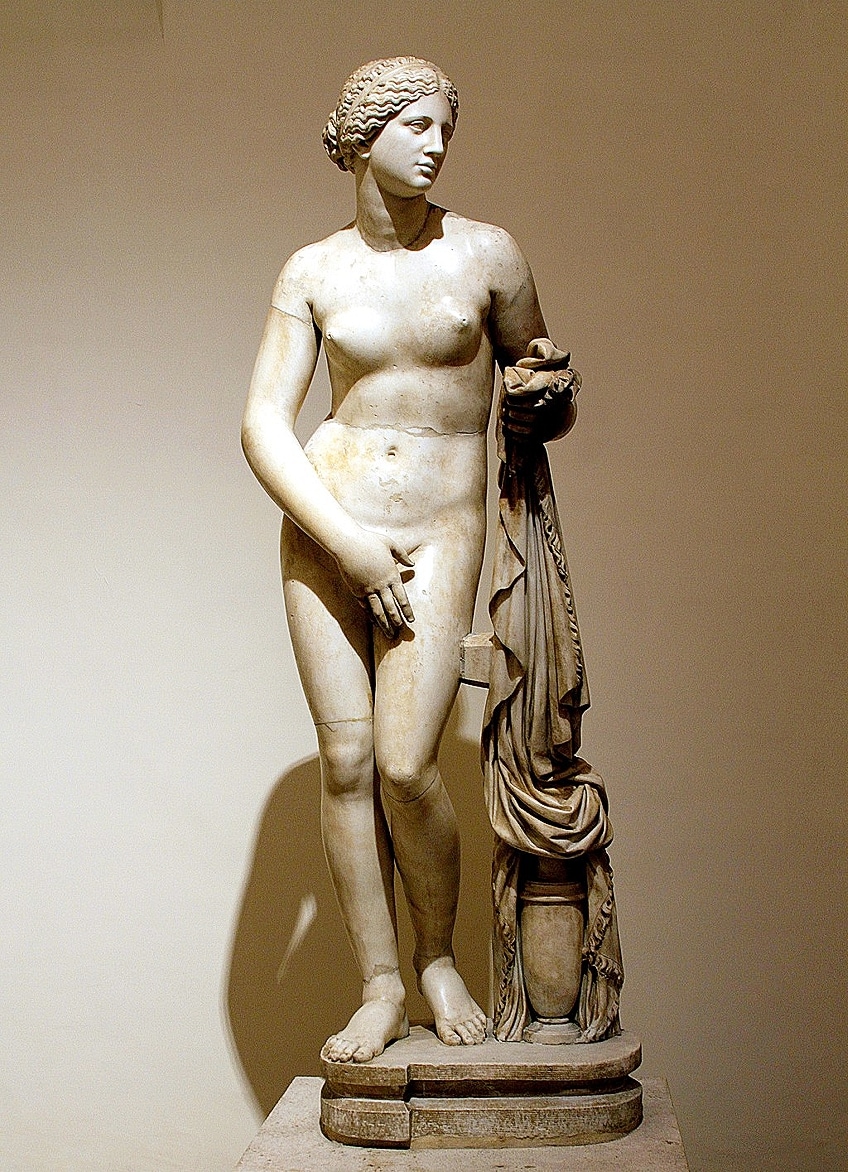 Aphrodite of Knidos (c. fourth century BC) by Praxiteles of Athens; José Luiz Bernardes Ribeiro, CC BY iv.0, via Wikimedia Commons
Aphrodite of Knidos (c. fourth century BC) by Praxiteles of Athens; José Luiz Bernardes Ribeiro, CC BY iv.0, via Wikimedia Commons
The Golden Ratio: The Dazzler Proportion
For Ancient Greek philosophers and artists akin, there was a close association betwixt beauty and truth. As the Aboriginal Greeks did, we tin can understand beauty and truth in mathematical terms. Aristotle's gilt mean represented the way to live a life of virtuous heroism by avoiding whatsoever extremes. For Socrates, all areas of virtue and beauty were manifestations of proportion and measurement.
Pythagoras and Euclid adult the golden ratio based on two quantities and the proportion between them. The ratio between these two measurements should be equal to the ratio between the larger measurement and the sum of the 2 measurements.
A substantial corporeality of Ancient Greek compages employed the golden ratio, with perhaps the most well-known being the Parthenon. Phidias oversaw the building of the Parthenon. Today, the golden ratio is known by the Greek letter phi to honor Phidias' contribution to the almost perfect building imaginable.
For many Classic artists and architects, the gilded ratio has remained an integral concept. Vitruvius, the Roman architect, used the gilded ratio, and his principles had a profound effect on the art and architecture of the Renaissance period. Even mod architects similar Le Corbusier detect inspiration in the golden ratio.
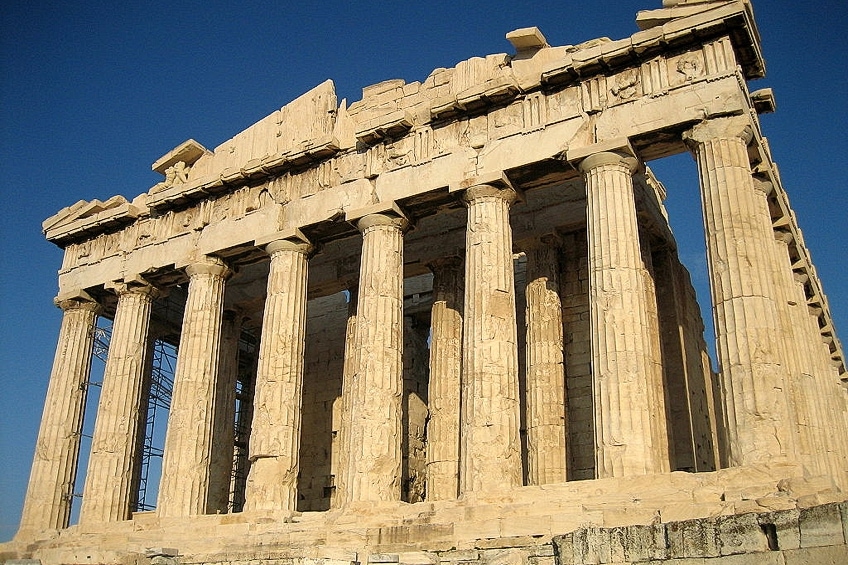 The Parthenon from the west; User:Mount, Public domain, via Wikimedia Commons
The Parthenon from the west; User:Mount, Public domain, via Wikimedia Commons
323-31 BCE: The Historic period of Hellenistic Greece
The Hellenistic era in Greece started with the expiry of Alexander the Nifty. Post-obit his decease, a political scramble left the Greek empire divided into three divide states. The influence of mainland Greek civilisation was in a gradual decline, while Hellenistic culture flourished in Egyptian Alexandria and Syrian Antioch. The immense wealth that remained in these epochs of the Greek empire led to the arts having regal patronage. Architecture, sculpture, and painting, in particular, flourished with backing from the majestic courts.
Lysippus was the official sculptor for Alexander the Great, and post-obit Alexander'south death, crafted bronze sculptures that mark the transition from Classical to Hellenistic styles. Some of the most well-known artworks from Aboriginal Greece were created during the Hellenistic catamenia.
Much of the art from the Hellenistic era had functional purposes. Early on Hellenistic sculptures were often, commencement and foremost, votive gifts and compages focused on civil monuments with social value. Creative value for Hellenistic artists came second to office.
Information technology was during the Hellenistic era that great strides in Greek architectural pattern took identify. With a focus on urban planning, Hellenistic architects designed theaters, parks, and buildings for other recreational activities. The Corinthian society is perhaps the well-nigh decorative Classic club and is exemplified in the colossal temples of the time.
The metropolis of Pergamon, known for its enormous architectural complexes, became a cultural epicenter of the Hellenistic menstruum. A stunning example of Hellenistic architecture is the Pergamon Altar. It was during the Hellenistic era that Greece became slowly integrated into the Roman Empire.
Ancient Greek Architecture: Laying the Foundations
Ancient Greek architecture is perchance best known for its temples that embody the cultural emphasis on formal unity. The temples were often rectangular and framed by open colonnades. Ancient Greek architects developed 3 orders of Classic architecture: the Corinthian, the Ionic, and the Doric. These orders fix the foundations for Roman architecture, and the concepts spread throughout Europe and America.
Each gild stemmed from distinct places and times in Ancient Greece. It is possible to distinguish between the architectural orders based on the capitals, the columns, and the entablature. The Doric gild uses round capitals, fluted or smooth columns, and entablature features that add a more elaborate and embellishing element to the simple design.
The use of scrolls or volutes to emphasis the elevation of the upper-case letter is typical of the Ionic society. Narrative frescos extend across the length of Ionic buildings as a result of the entablature design. The Corinthian guild is a later Classical architectural blueprint named after the city of Corinth. Corinthian architecture is by far the most elaborate, with acanthus leaf motifs and decoratively carved capitals.
The first Aboriginal Greek temples were constructed from wood using a post and axle design. Rock and marble became increasingly popular, and the Parthenon was the commencement temple to be synthetic entirely from marble. Ancient Greek architects were pioneers of the amphitheater and the stadium. The Romans later appropriated these architectural structures.
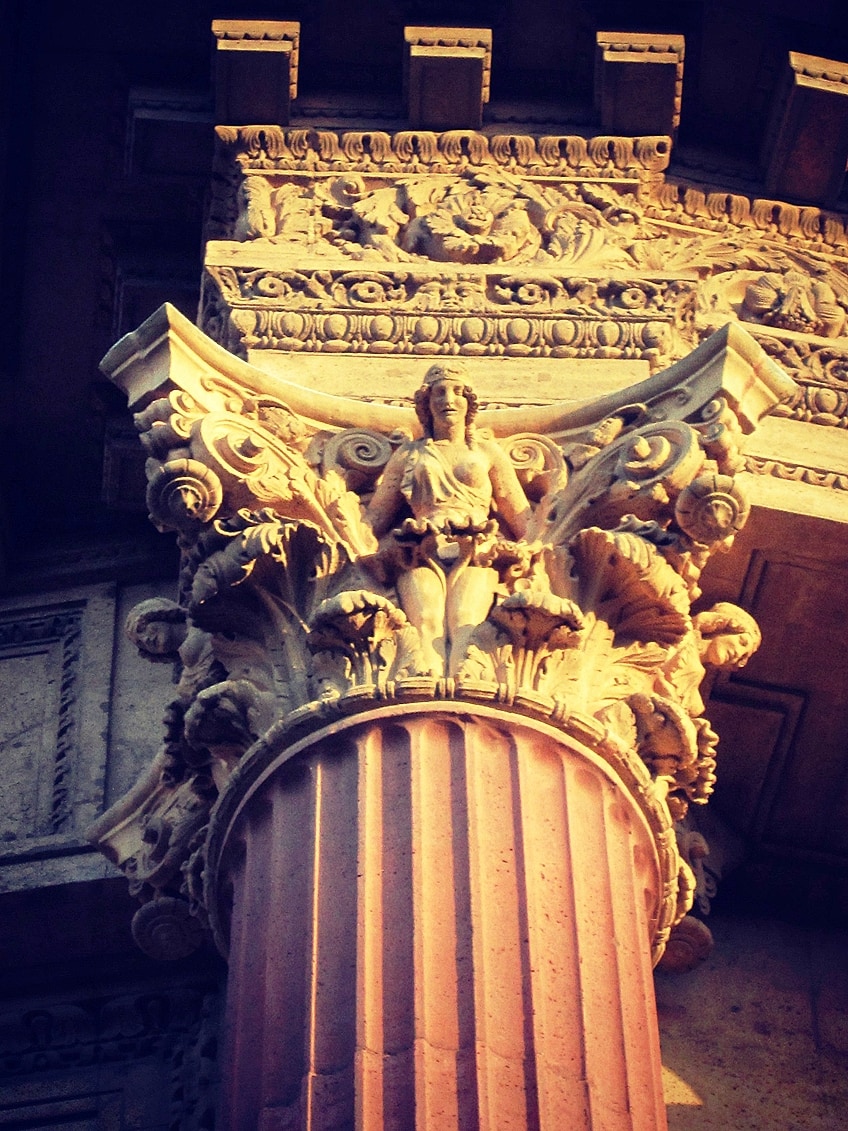 A Corinthian Order upper-case letter; Amanda Sidell, CC BY-SA 4.0, via Wikimedia Commons
A Corinthian Order upper-case letter; Amanda Sidell, CC BY-SA 4.0, via Wikimedia Commons
Frescos: A Bridge Between Ancient Greek and Roman Classicism Menses art
Although architecture and sculpture are the most common forms of Classical fine art, Greek and Roman painters fabricated classical innovations in console and fresco painting. Almost of what we know nigh Classical Greek painting comes from the painted vases and Roman and Etruscan murals influenced by the Greeks. 1 stunning example of Archetype Greek frescos is the landscape Hades Abducting Persephone in the Vergina tombs. This mural reflects the increased realism of Greek paintings and sculptures of this time.
A not bad deal more Roman fresco and panel paintings survive. The excavation of Pompeii in 1748 revealed several very well-preserved Roman frescos in residences like the Business firm of the Vettii, the House of the Tragic Poet, and the Villa of Mysteries. These fresco paintings brought a sense of color, lite, and space into interiors that were oft dark, cramped, and lacked windows.
Popular fresco subjects included scenes from the Trojan war, religious rituals, landscapes, mythological tales, still lifes, and erotic scenes. Ofttimes walls would be painted to resemble alabaster panels or brightly colored marble, frequently enhanced by illusionary cornices or beams.
Central Stylistic Contributions From the Roman Empire
In the Roman Classicism period, fine art took a dandy deal of inspiration from the artistic and cultural developments of Aboriginal Greece. Edifice on the Greek valorization of heroic figures and grand architecture, the Romans build cities, commissioned public art, and adult Classical portraiture.
509 BCE-26 CE: The Roman Republic
The Roman Senate, a collection of noblemen, elected the kings in the Roman Democracy, which began as an immense urban center-country. Rome became a Republic post-obit the expulsion of the concluding Rex, Lucius Tarquinii Superbus, in 509 BCE. Tarquinii was deposed by the husband and father of a noblewoman raped by his son. Not only was this story central to the History of the Roman Commonwealth, but it was also a central subject field of Roman art in the centuries that followed.
Post-obit the abolitionism of kingship, the Roman Republic established a new governing organization led by ii consuls. The governing upper course and the mutual people were ofttimes in disharmonize, and this state of affairs inspired much of the architecture in early Rome. City planning on a grid organisation emphasized public entertainment facilities to go along the peace. In the tertiary century, the Romans developed physical revolutionizing technology and architecture.
Many of the Greek stories of heroes and gods were adopted past Roman civilisation, alongside their way of the ancestors' traditions. This tradition was an nigh contractual relationship between Rome's founding fathers and the gods. Greek sculptures taken during the war were often displayed in Roman homes, public places, and palaces on the basis of their aesthetic value.
The Greek Classical traditions discussed to a higher place were the primary influence on Roman architecture and art.
The Physical Revolution: Classical Advances in Roman Architecture and Engineering
The Romans took architectural advancement to new levels. Technological innovations, including the invention of concrete, meant that architectural pattern was no longer limited to bricks and mortar. The dome, barrel vault, curvation, and groin vault were Roman architectural innovations.
The Roman era saw an historic period of incredible architecture, not just for pleasure like the Colosseum, simply also to amend city life like aqueducts, bridges, and apartment buildings. The arch is one of the most influential architectural developments from Roman Classicism. The segmental arch was pioneered for apply in bridges and homes, while the triumphal and extended arches celebrated the emperor's victories.
The use of the dome is by far the near significant innovation of Classical Roman architecture. Roman architects were influenced by Greek architectural styles and the Etruscan use of hydraulic technologies and arches. Even when porticos, columns, and entablatures were no longer needed for structural integrity thank you to technological advancements, the Romans still used them.
Vitruvius is the about famous Roman builder and engineer. Between 30 and fifteen BCE, while working for the military of Augustus, Vitruvius wrote the Ten Books on Architecture. These books are a record of Roman architectural theory and practice, describing the process of town planning, religious building, unlike building materials, aqueducts and h2o supplies, and various types of Roman machinery like cranes and hoists.
The Vitruvian Triad refers to Vitruvian'southward theory that whatsoever built structure should have the qualities of dazzler, stability, and unity. The Vitruvian architecture reflects the proportionate beauty of the natural globe and the human being course. The extension of Vitruvian proportion to the human effigy is reflected in Vitruvian Human being (1490) past Leonardo da Vinci.
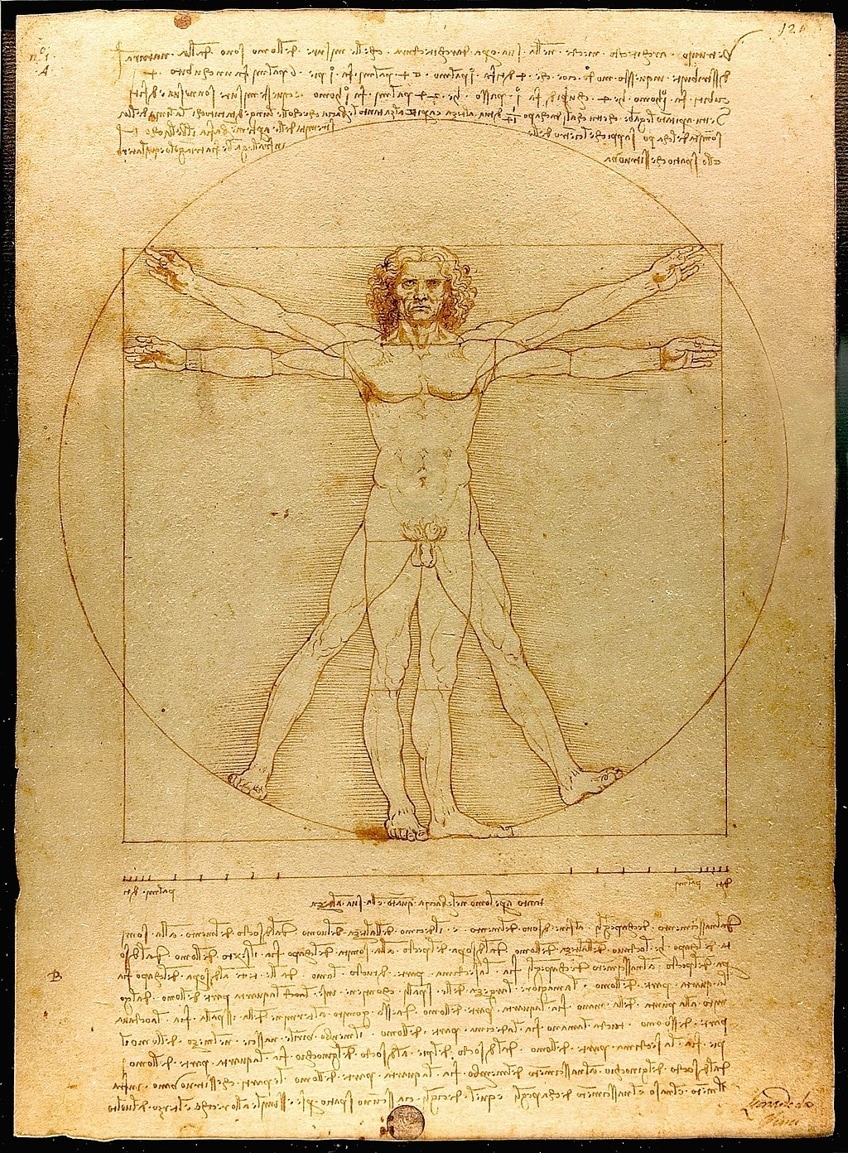 Vitruvian Man (1492) by Leonardo da Vinci; Leonardo da Vinci, Public domain, via Wikimedia Eatables
Vitruvian Man (1492) by Leonardo da Vinci; Leonardo da Vinci, Public domain, via Wikimedia Eatables
27BCE-393 CE: The Imperial Roman Empire
Despite the ceremonious war that followed Caeser's try to become emperor, Augustus eventually became the beginning emperor of Regal Rome. Augustus reigned for near 45 years, and during this time, he created the first constabulary strength, postal system, fire fighting force, and municipal offices. The taxation and acquirement systems implemented by Augustus immune him to transform the arts and launch a new program of building temples and public buildings.
Artistic works like Augustus of Prima Porta were deputed and played into the Classical Greek fashion of arcadian representation. The lavish art of Imperial Rome defined this menses. Thousand architectural buildings were decorated with extravagant frescos and commissioned portraits of the wealthy.
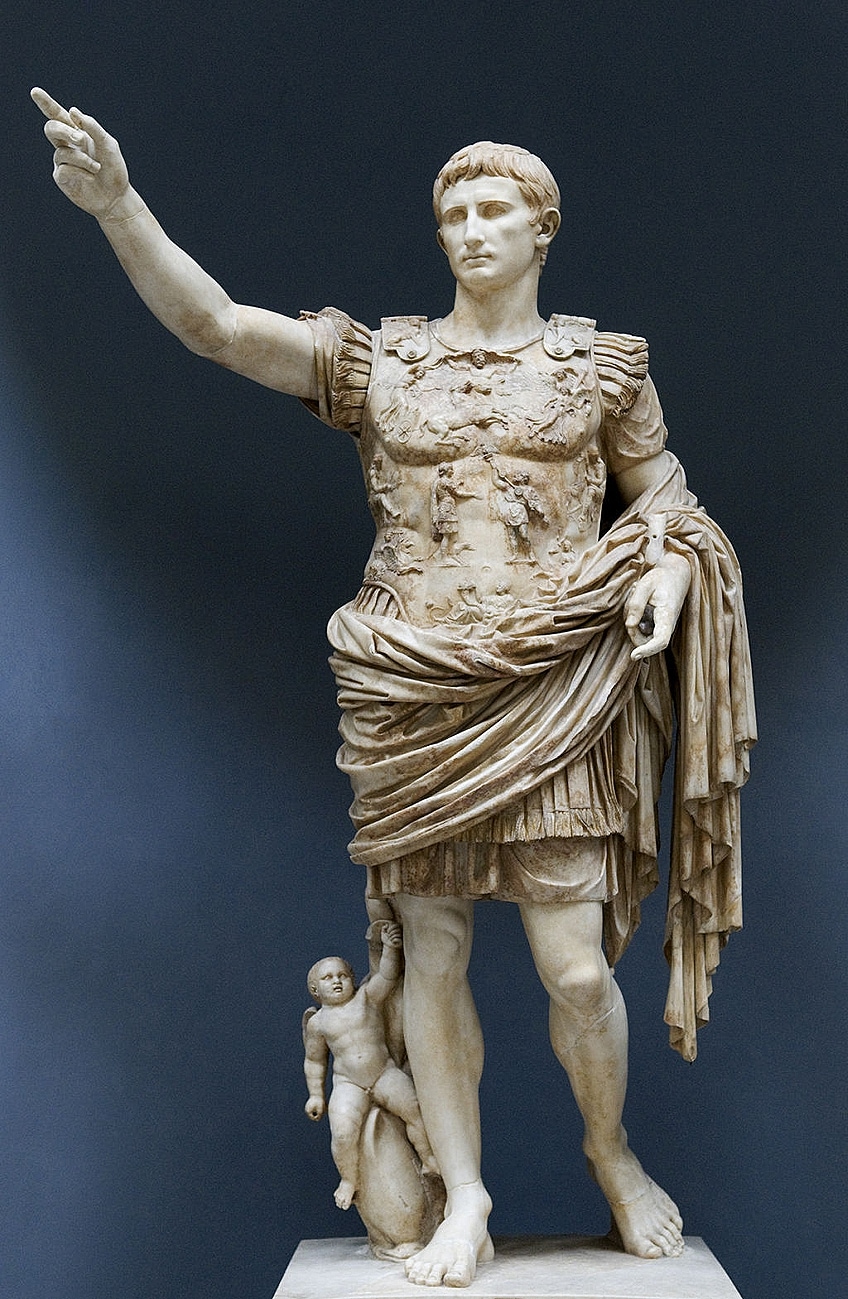 Augustus of Prima Porta, 1863; Michal Osmenda from Brussels, Kingdom of belgium, CC By-SA 2.0, via Wikimedia Commons
Augustus of Prima Porta, 1863; Michal Osmenda from Brussels, Kingdom of belgium, CC By-SA 2.0, via Wikimedia Commons
Roman Portraiture: Contributions to Classicism
While many Classic Roman sculptures are little more than copies of Classic Greek sculptures, portraiture is where Roman innovation came into its own. These early Archetype portraits emphasized realism. Early Romans felt that representing a powerful man in the most honest style possible was a sign of character.
The tables turned once emperors were reinstated during Royal Rome. Portraiture in Imperial Rome was idealistic, producing potent politically motivated images presenting the emperors as descendants of heroic Greek and Roman history. This practice led to the development of a Greco-Roman fashion of relief sculpture.
Roman portraiture too found inspiration in a Greek method of glass painting. Small portraits on medallion-sized pieces of glass or roundels from drinking glasses were pop. Personalized drinking cups containing gold glass portraits were popular among the most wealthy Romans and post-obit their death, these drinking glass portraits would exist cutting into a medallion shape and placed into the cement walls of the tomb.
Among the most famous Roman portraits are those found on mummified bodies in Fayum. This set up of portrait panels was preserved past the dry Egyptian climate and is the largest surviving collection of Archetype Roman era portraiture. These portraits display an intermingling of Ancient Egyptian and Classical Roman traditions while Egypt was under Roman dominion. The style of these portraits is quite idealistic but the features of each private are naturalistic and distinct.
Long Live Classicism
The Legacy of Classicism did not fall with the Roman Empire. The influence of Classical Greek and Roman architecture and art permeates all art periods and movements in the Western earth. Greek art and Roman architecture were influential for the Byzantine and Romanesque periods.
It was the Italian Renaissance that really took inspiration from the Classical mode of Greek and Roman fine art and architecture. The architectural practice and theory of architects like Palladio and Leon Battista Alberti are informed by Vitruvius' writings, the Pantheon, and the Parthenon.
The Italian Renaissance: Classicism Fine art Revival
The Italian Renaissance period in the 15th and 16th centuries is perhaps one of the more durable revivals of Greco-Roman Classicist art. Transitioning from the dark ages of art and culture, European artists, philosophers, and humanists renewed their interest in Classical artifact. Like Greco-Roman Classicism, the Italian Renaissance period is hailed for its achievements in literature, architecture, painting, philosophy, technology, sculpture, and scientific discipline.
Equally nosotros have explored in Greek and Roman fine art and architecture, proportion, dazzler, and orderliness were central elements of Italian Renaissance Classicism art. The gilt rectangle proportion associated with Roman and Greek architecture found a revival in Renaissance architectural models. Renaissance artists similar Albrecht Durer, Raphael, Michelangelo, and Leonardo da Vinci were influenced by Greek sculpture, as were afterward artists from the Baroque period like Bernini. Below, you lot can come across the golden ratio's proportions displayed in da Vinci'due south famousMona Lisa painting.
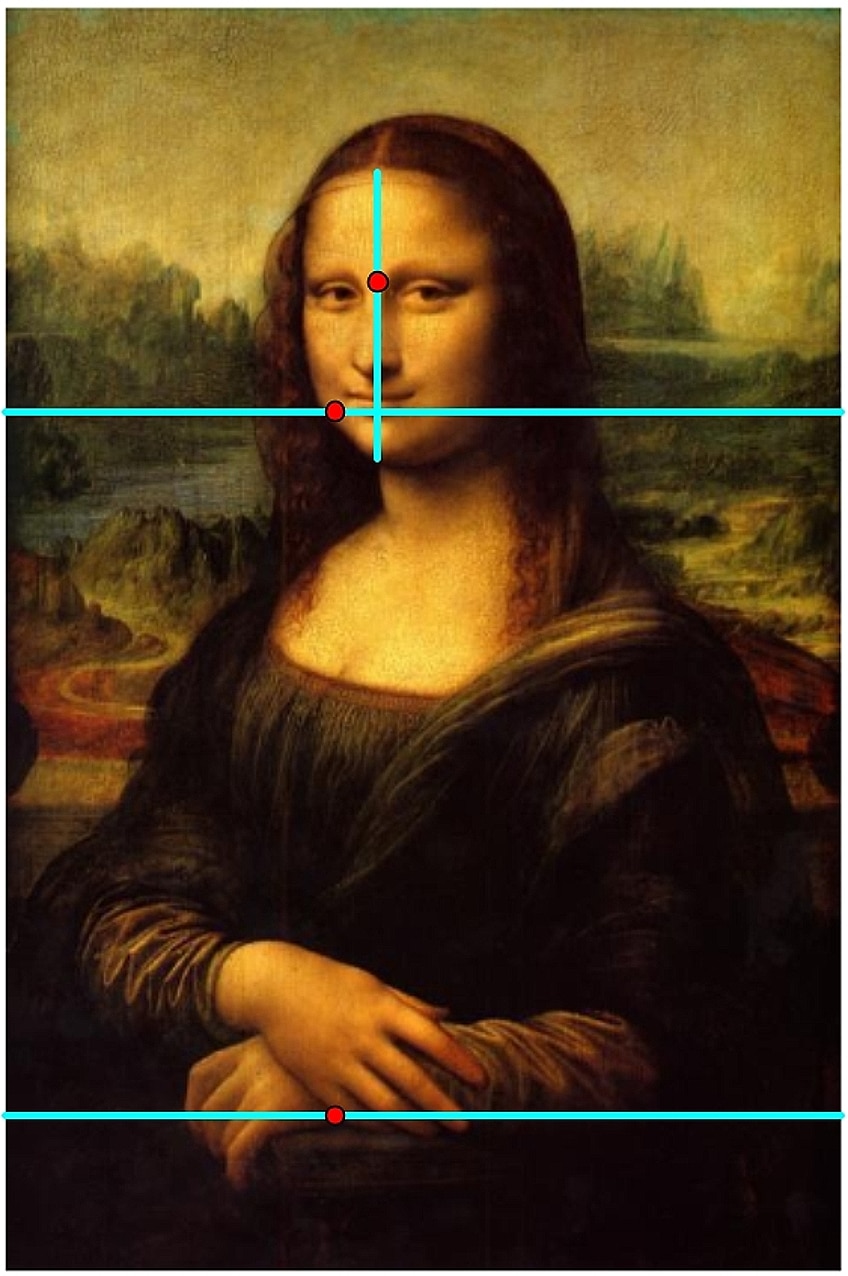 The golden ratio in Leonardo da Vinci's Mona Lisa (1503); Mabit1, CC Past-SA 4.0, via Wikimedia Commons
The golden ratio in Leonardo da Vinci's Mona Lisa (1503); Mabit1, CC Past-SA 4.0, via Wikimedia Commons
Neoclassicism: Reinventing Classical Ideas
The terms Classicism and Neoclassicism are often confused because of their similarity. While Classicism denotes the particular artistic, architectural, and philosophical artful of the Ancient Greeks and Romans, Neoclassicism reflects any subsequently false of these Classical styles.
Neoclassicism broadly refers to the way of Classical imitation, but it likewise refers more than specifically to an artistic movement in Western Europe during the 18th century. This art motility began in Rome, post-obit the discovery of Pompeii. Shortly, Neoclassical aesthetics based on Roman and Greek ideas spread throughout Europe.
The Neoclassical art movement occurred in parallel to the Historic period of Enlightenment during the 18th century and connected into the 19th century. In terms of architecture, Neoclassical aesthetics have continued to be influential in the 21st century. The Neoclassical architectural style emphasizes symmetry and simplicity, tokens from Rome and Ancient Greece, and taken straight from Renaissance styles.
The Neo in Neoclassicism points to the difference between this style and its Greco-Roman inspiration. Neoclassical artists, writers, and sculptors chose some models and styles from Classicist fine art and ignored others. For instance, Neoclassical artists paid homage to the sculptural ideas from Phidias' generation, simply the sculptures that were actually produced are more similar to the Roman remakes of Hellenistic sculptures. Drawings and engravings that reconstructed Greek buildings mediated the Neoclassical impressions of Greek architecture. Neoclassical artists entirely ignored artistic and architectural styles from Primitive Greece.
Although the roots of Classicism experience as though they are in the distant past, the artful ideas go along to permeate many aspects of modern Western life. From architectural designs using cement and arches to the fundamentals of drawing the human figure and influential works of literature, Greco-Roman Classicism is all around united states of america. The Renaissance and Neoclassical commemoration of Classical aesthetics is a testament to the innovation of early Greek and Roman artists and architects.
Take a wait at our Classical Fine art catamenia webstory here!
Source: https://artincontext.org/classical-art/
Enviar um comentário for "What Are the Characteristics of Classical Art Ancient Greece"